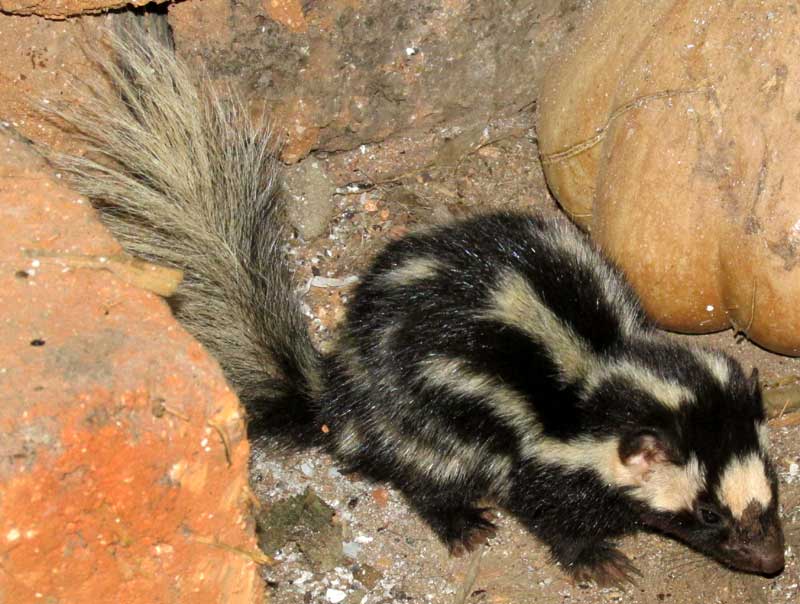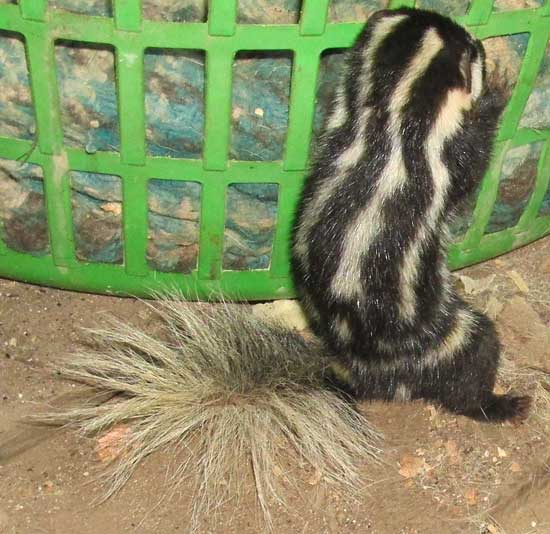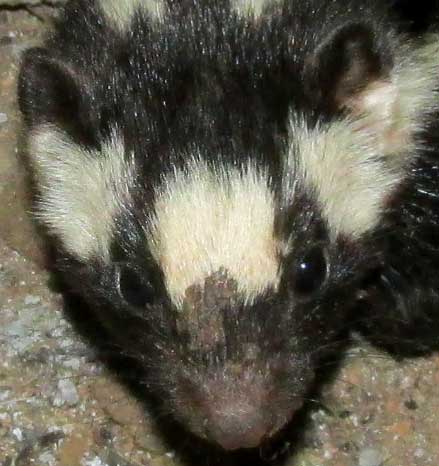Excerpts from Jim Conrad's
Naturalist Newsletter
from the December 24, 2017 Newsletter issued from Rancho Regensis north of Valladolid, Yucatán, MÉXICO;
elevation ~40m (~130 ft), N~20.876°, W~88.170°
AN AGGRESSIVE SPOTTED SKUNK

At dusk I sat on the hut's porch reading with Katrina the dog snoozing next to me. I was just about ready to turn off my Kindle because of failing light when movement on the hut trail caught my attention. It was a skunk, nearer to the size of a rat than to what Eastern North Americans think of as skunk size. It was the same species, Spilogale angustifrons ssp. yucatanensis, I'd encountered on a November morning at dawn in 2004, in northwestern Yucatan, back when I didn't have a camera, and ever since then I'd been hoping for a return visit. And this time I had my camera ready beside me. {The 2004 encounter is related in the next section.}
One reason I wanted a return visit was because that other time the little critter had walked right up to me, did a handstand with his back legs skyward and his tail curved over his back, seeming ready to spray me, and I took off running. He chased me for 150 yards, then climbed up the screen of the door I'd slammed between us, still trying to get at me. Later I'd read that this was typical behavior of a hormone-saturated male looking for a female, at least of the Yucatan subspecies. Now I hoped to conduct our interview with more valor displayed on my part.
The English name for Spilogale angustifrons is Southern Spotted Skunk. When this week's visitor waltzed onto the porch he went directly to Katrina, who watched him approach big-eyed, then jumped from her basket and ran onto the trail. At the bedding basket the skunk reared up and sniffed and pawed. Having a good view of his back, I was reminded how misleading the name Spotted Skunk is. Below, you can see the reason in a flash-assisted picture:

He's as striped as he can be, and the other three species of the genus Spilogale -- all known as spotted skunks -- are nearly as spotless. From Katrina's basket he shuffled across the floor and explored my adobe-brick fireplace, providing the nice frontal view, shown at the top of this page.
Then, despite my having taken several flash-assisted pictures, he seemed to notice me for the first time. As he drew near, I had no intention of running away like the last time -- not even when he suddenly did a handstand with back paws skyward, curled his tail over his back, and seemed ready to squirt me. I didn't get squirted the last time so I figured I wouldn't get it this time. He smelled a little skunky, but despite his threatening stance he didn't produce any skunk juice at all.
Giving up on trying to intimidate me, he came over and sniffed my foot. It was an unusually chilly evening, so I was wearing hand-knitted woolen socks and pajama bottoms. He began chewing on my socks. I didn't want the socks damaged so I tried to shake him off, but he would let go. Thinking he might go away if I just sat quietly, after about 15 seconds he released his bite on my socks, but immediately reared onto his back legs and began biting my pajama bottoms, as shown below:

At this point I began shaking my leg with vigor, but he just wouldn't let go until I gave him a whack from the side knocking him off. Then I got up and ran to stand beside Katrina who had been watching with a worried look on her face. The skunk came and chased both of us around a big limestone boulder beside the trail. After circling twice I got my composure back and went and sat down again. The skunk returned, but this time I kept my legs up on the table. He tried to reach them by jumping but gave up. He wandered around awhile longer until it got dark, then he went into my woodpile and seemed content to stay there.
With no electricity here, when darkness comes I go to bed, so now I spread my sleeping bag on the plastic sheet covering the hut's cement floor, beneath the mosquito net. Just as I was dozing off something started nudging my right foot from outside the net. I knew it was the skunk looking for half-buried beetles and grubs beneath my sleeping bag, the same as he would beneath a big rock. Maybe if I ignored him he'd go away. But, he didn't. Systematically he worked all the way up my right side, then back to my feet and started up the left side.
I thought maybe I could scare him off by shining my flashlight through the mosquito net netting into his face, but he ignored it. When I pushed the flashlight right into his face, he lunged at it and through the netting bit into the plastic rim around the flashlight's lens, the face cap, and wouldn't let go for over a minute. Then I decided to just let him tire himself out looking for grubs beneath me.
But, when he came up on the left side and nuzzled into my armpit, I realized that he'd gotten inside the mosquito net.
Finally I decided to take decisive action. I got from beneath the net and shoved the shining flashlight into his face like before, but without the netting between us. Again he bit into the flashlight's face cap, and as he hung on I lifted him and deposited him into a wide-mouth gallon jar used for solar cooking. After two or three minutes he released his grip and I got the flashlight back. Then a top went onto the jar, and I carried him to the garden on the other side of the tool shed, far enough away to have hope he wouldn't come back. And he didn't.
Below, you can see the little critter's face -- the single white spot on the forehead apparently characterizing all four species in the genus, but not spot enough to warrant calling them all spotted skunks:

from the November 28, 2004 Newsletter issued from Hacienda Komchen de Los Pájaros
just outside Dzemul, Yucatán, MÉXICO
SPOTTED SKUNK ENCOUNTER
Monday morning at dawn I was standing next to a pond hoping to see some wildlife when down the trail came a small, black critter with large white spots, and about the size of a normal rat. The binoculars showed it to be a Spotted Skunk, SPILOGALE ANGUSTIFRONS ssp YUCATANENSIS, and I was thrilled to think I might see it foraging for food along the water's edge. I stood perfectly still, trying to be "invisible."
The skunk passed right by the pond and continued bounding down the trail toward me. I could hardly believe my luck. Closer and closer he came until he was so near that my binoculars couldn't focus on him. I lowered my binoculars and as the skunk continued coming right at me I began thinking that I was not seeing standard skunk behavior.
In fact, that skunk ran right up to within a foot of my feet, suddenly did a hand-stand on his front legs with his back legs pointing skyward and his tail curled over his back. Not wanting to be squirted, I took off running.
Assuming that once the skunk saw me moving he'd be frightened and escape in the opposite direction, I proceeded only a few feet before stopping and looking back. The skunk was running after me. I ran 20 feet more and by golly that skunk stayed right behind me. I was barefooted and the trail was rough with jagged rocks so running was a painful business, but I did it anyway.
The skunk chased me a good 150 yards before I made it back to my little bungalow and just barely got the screen door slammed before he arrived and began sniffing and pushing furiously against the door's base. Then he actually climbed up the screen itself, but only got about a yard high before falling off. This he did several times.
I'd never heard of this kind of behavior in a skunk so I wondered whether I might have run into one with rabies. Fortunately I had a book describing certain Mexican mammals, including skunks (Fauna Sylvester de Mexico by A.S. Leopard), and it told me just what I wanted to know.
"The Spotted Skunk is more lively, agile and aggressive than the larger species," I read. "When Spotted Skunks feel threatened they often quickly attack their aggressor, and this habit has given rise to the false notion that Spotted Skunks are rabid... They've told me that in the Yucatan {they} attack without provocation, and that the most violent attacks take place when the male is looking for a female... "
So, I'd been witness to a behavior that was normal for the Yucatan subspecies of Spotted Skunk. I felt honored.
For the rest of the day that little skunk ran up and down the road and even in the middle of the day came sniffing and running around the big pool near the main residence. If he was looking for a lady skunk, he must have been absolutely intoxicated by his hormones, for rushing around like that in broad daylight isn't at all skunk-like.
That night I took a walk and in the moonlight saw him coming down the road. This time I let him come right up to me and actually get atop my bare feet. I couldn't see him clearly but it felt as if he did some kind of dance there, before I lost my nerve and once more ran away.
Sadly, the next morning we found him drowned in the big pool. I wasn't surprised, having seen how he rushed wherever he went.
This is one skunk I won't forget. Of course Ana María had to point out that a few weeks ago when I encountered a Mountain Lion in California I'd hardly broken my stride while jogging, yet this little Mexican skunk had managed to make me run down the road twice. I think the folks here regard that as one point for Mexico.